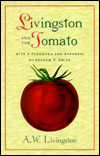|
You can purchase our seeds at the Victory Seed
Company
Tomato Seeds
by Color or Type
Bi-Color Tomato
Seeds
Black Tomato Seeds
Brown Tomato Seeds
Dwarf Tomato Seeds
Green Tomato Seeds
Orange Tomato
Seeds
Pink Tomato Seeds
Purple Tomato Seeds
Red Tomato Seeds
Striped Tomato Seeds
White Tomato Seeds
Yellow Tomato Seeds
Livingston Tomato Seeds
Paste Tomato Seeds
Cherry Tomato Seeds

|
For
More Information About A. W. Livingston |
|

"Livingston
and the Tomato"
by A. W. Livingston with a forward by Andrew F. Smith First
published in 1893, Livingston and the Tomato contains both
descriptions and drawings of the tomato varieties he introduced. The
book features over sixty tomato recipes, including ones for slicing,
frying, escalloping, baking, and broiling tomatoes; as well as for
tomato toast, custard, soup, pie, preserves, figs, jam, butter,
salad, sauce, and omelets.
Click
Here for purchasing information |
|
CORVALLIS, March 7, 2003 - Oregon State
University Agricultural Experiment Station vegetable breeders have developed
a
late blight resistant, yet early-bearing tomato. Seeds and
transplants of this promising tomato, called 'Legend,'
will be available at seed companies and nurseries this spring.
'Legend'
sets fairly large fruit under the cool maritime conditions of the Pacific
Northwest. Plant breeders classify tomatoes such as these as
"parthenocarpic," because they set fruit without fertilization. This means
that the cool weather of western Oregon summers that slows down pollinators
won't affect the fruit set of this type of tomato plant; parthenocarpic
tomato plants set fruit without a pollinator's help.
"We think that parthenocarpic varieties
are earlier because they are setting fruit when non-parthenocarpic varieties
are dropping their blossoms, because cold weather prevents fertilization,"
explained
Deborah Kean, a research assistant at the OSU vegetable research
farm outside of Corvallis.
With considerably larger fruits than 'Oregon
Spring' or 'Siletz'
- other OSU-developed early varieties - 'Legend'
sets fruit earlier than 'Oregon
Spring' and sometimes earlier than 'Siletz'.
The 'Legend'
plant appears to be stronger, with larger stiffer leaves than the other two
varieties. 'Legend' is a determinate plant, typically spreading to 36 inches
in good growing conditions.
As a bonus, 'Legend'
is resistant to
late blight, a fungal disease that kills tomato plants in home
and market gardens. Late blight is caused by the same fungus (Phytophthora
infestans) that caused the famous
Irish potato famine of the 1840s. All strains are devastating to
tomatoes and potatoes.
With mid-May planting of transplants, the
first 'Legend'
fruits typically ripen at the OSU Vegetable Research Farm outside of
Corvallis by about Aug. 1, with an early peak of production.
To grow your own 'Legend'
transplants, seed should be started indoors about mid-April if you have
ideal growing conditions, with heated soil and grow lights. If you are
starting your seeds in a window or in an unheated greenhouse, it is better
to start them as early as the first half of March, advised
Kean.
'Legend'
fruits are round, averaging about a half-pound each, but may reach or exceed
a pound, and they are nearly four inches wide. 'Legend'
has more uniform ripening than 'Siletz'
or 'Oregon
Spring'.
Resistance to a disease like late blight is
different from immunity, warned
Jim Myers, OSU vegetable breeder who helped develop 'Legend'.
"What we mean by resistance is that
progress of the disease is slowed," explained
Myers. "Gardeners can expect a two- to three-week longer
harvest period than susceptible tomato cultivars. But given the right
weather,
late blight may eventually overcome the resistance. Resistance is
not an 'end all'."
"Late
blight is a difficult disease for which to breed because there are a
number of different races of
late blight," he added. "Genes in the tomato plant for
resistance are race specific, so if a new race invades, or the old race
mutates, then resistance may break down. Resistance has held up in Oregon,
but I've had reports of it breaking down on Vancouver Island (in British
Columbia) and in the San Francisco area."
Myers worked with
Dr. James R.
Baggett, retired OSU vegetable
breeder, to develop 'Legend'.
Both
Baggett
and
Myers believe that 'Legend'
is an overall superior tomato to 'Siletz'
and 'Oregon
Spring', even without considering its
late blight resistance.
By:
Carol Savonen
Source:
Jim Myers,
Deborah Kean |